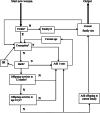Lifehistory Trade-Offs Influence Women's Reproductive Strategies
- PMID: 38686093
- PMCID: PMC11055690
- DOI: 10.1007/s40750-024-00236-3
Lifehistory Trade-Offs Influence Women's Reproductive Strategies
Abstract
Objective: In a UK national census sample, women from the upper and lower socioeconomic (SES) classes achieve parity in completed family size, despite marked differences in both birth rates and offspring survival rates. We test the hypothesis that women adopt reproductive strategies that manipulate age at first reproduction to achieve this.
Methods: We use a Monte-Carlo modeling approach parameterized with current UK lifehistory data to simulate the reproductive lifehistories of 64,000 individuals from different SES classes, with parameter values at each successive time step drawn from a statistical distribution defined by the census data.
Results: We show that, if they are to achieve parity with women in the higher socioeconomic classes, women in lower socioeconomic classes must begin reproducing 5.65 years earlier on average than women in the higher SES classes in order to offset the higher class-specific mortality and infertility rates that they experience. The model predicts very closely the observed differences in age at first reproduction in the census data.
Conclusions: Opting to delay reproduction in order to purse an education-based professional career may be a high risk strategy that many lower SES women are unwilling and unable to pursue. As a result, reproducing as early as possible may be the best strategy available to them.
Keywords: Contingent decisions; Lifehistory; Reproductive decisions; Socioeconomic class; Women.
© The Author(s) 2024.
Conflict of interest statement
Conflict of InterestThe authors declare that they have no conflict of interest.
Figures



References
-
- Becker, G. S. (1981). A treatise on the family. Harvard University Press.
-
- Becker, G., & Lewis, H. (1973). Interaction between quantity and quality of children. In T. Schultz (Ed.), Economics of the family: Marriage, children and human capital. Chicago University Press.
-
- Belsky, J., Schlomer, G. L. & Ellis, B. J. (2012). Beyond cumulative risk: distinguishing harshness and unpredictability as determinants of parenting and early life history strategy. Developmental Psychology, 48, 662-673. - PubMed
LinkOut - more resources
Full Text Sources
Research Materials
